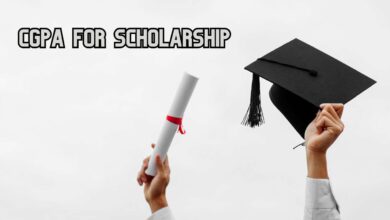장학금을 받으려면 가장 높은 GPA는 얼마입니까?

오늘날 학생들은 고등 교육 비용을 절감하고 싶어 합니다. 장학금, 특히 전액 장학금은 많은 학생들에게 희망의 등불과 같습니다. 하지만 이러한 장학금을 받는 과정에는 어려움이 따릅니다. 학생의 GPA는 전액 장학금을 받을 수 있는지 여부를 결정하는 중요한 요소입니다. 장학금에 대해 살펴보고, 장학금 수혜를 위한 최고 GPA는 얼마인지 알아보겠습니다.
장학금의 중요성
장학금은 학생들이 많은 학자금 대출 없이 좋은 교육을 받을 수 있도록 도와줍니다. 장학금은 학생의 학업 기간 동안 학비와 생활비를 충당하는 데 도움이 될 수 있습니다. 장학금은 인기가 많으며 학생의 교육에 큰 영향을 미칩니다.
장학금 자격 이해
장학금은 종류와 규모에 따라 다양한 기준을 가지고 있습니다. 자격 요건에는 시험 점수, 활동, 학년 등수, 그리고 GPA가 포함될 수 있습니다. 이 섹션에서는 장학금 자격 요건과 GPA에 대해 자세히 살펴보겠습니다.
장학금에서 GPA의 역할
학생의 GPA는 학업 성취도를 측정하는 중요한 지표입니다. GPA는 학생의 헌신, 꾸준함, 그리고 학업에서 뛰어난 성과를 낼 수 있는 능력을 반영합니다. 장학금 지급에서 GPA의 중요성은 장학금 제공 기관에 따라 다를 수 있습니다.
성적 우수 장학금
성적 우수 장학금은 뛰어난 학업 성취를 보인 학생들에게 수여되는 경우가 많습니다. 4.0 GPA는 인상적일 뿐만 아니라 장학금 제공자들의 관심을 사로잡는 데에도 도움이 됩니다. 하지만 GPA는 전체 퍼즐의 한 조각일 뿐이라는 점을 기억하는 것이 중요합니다.
최소 GPA 요구 사항
전액 장학금은 일반적으로 최소 GPA를 포함한 특정 요건을 충족해야 합니다. 이러한 장학금의 표준 최소 GPA는 일반적으로 3.5입니다. 하지만 곧 알게 되겠지만, 모든 장학금이 이 엄격한 기준을 충족하는 것은 아닙니다.
4.0 GPA로 전액 장학금을 받을 수 있나요?
4.0 GPA를 받는 것은 쉽지 않습니다. 장학금 지원자 중 이를 달성하는 사람은 많지 않습니다. 4.0 GPA가 전액 장학금 및 위원회의 기타 고려 사항을 보장하는지 알아보세요.
4.0 GPA의 대안
4.0 GPA를 목표로 하는 것은 칭찬할 만한 일이지만, 모든 학생이 이 높은 목표를 달성할 수 있는 것은 아닙니다. 하지만 이 완벽한 점수에 미치지 못하는 학생들을 위한 대안이 있습니다. 이 섹션에서는 학생들에게 전액 장학금을 받을 수 있는 GPA에 대해 설명합니다.
“좋은 GPA” 범위
4.0 GPA는 매우 뛰어나지만, “좋은 GPA”는 일반적으로 3.5에서 3.8 사이입니다. 장학금 제공 기관은 모든 학생이 완벽한 GPA를 받을 수 있는 것은 아니라는 점을 알고 있습니다. 따라서 3.5에서 3.8 사이의 높은 성취도를 가진 학생을 우대합니다.
GPA 향상
GPA를 높이고자 하는 학생들을 위해 다양한 전략과 자료를 제공합니다. 이 섹션에서는 성적을 향상시키고 장학금을 받는 방법에 대한 팁을 제공합니다.
전액 장학금의 과제
전액 장학금은 경쟁률이 매우 높으며, 최고 자격을 갖춘 지원자에게만 제공됩니다. 전액 장학금은 신청하기 어렵고, 선발 과정에는 여러 요인이 영향을 미칩니다.
강력한 장학금 신청서 작성
전액 장학금을 성공적으로 받으려면 높은 GPA 이상의 것이 필요합니다. 이는 장학금 신청서의 핵심 요소인 성적, 활동, 그리고 리더십을 보여줍니다.
기회를 늘리는 전략
향상된 문장을 위해 플레쉬-킨케이드 등급 8점 이하를 목표로 하고 있나요?
완벽한 GPA를 넘어: 전체론적 접근 방식
모든 사람이 완벽한 4.0 GPA를 유지할 수 있는 것은 아니며, 장학 위원회는 이를 잘 알고 있습니다. 장학 기관은 다재다능하고 역동적인 인재를 선발하기 위해 다음과 같은 다양한 요소를 고려합니다.
1. 시험 점수
SAT나 ACT 같은 시험 점수는 장학금 신청에 중요합니다. 좋은 시험 점수는 낮은 GPA를 만회하고 학업적 잠재력을 보여줄 수 있습니다.
2. 과외 활동
스포츠, 동아리 활동, 자원봉사, 리더십 활동은 여러분을 돋보이게 할 수 있습니다. 이러한 경험은 여러분의 헌신, 팀워크, 그리고 리더십 역량을 보여줍니다.
3. 리더십 기술
장학 위원회는 리더십을 발휘하는 학생들을 높이 평가합니다. 학교 동아리나 지역 사회 단체에서 리더로 활동한 경험이 있다면 지원서에 반드시 기재하세요.
4. 추천서
추천서는 당신이 어떤 사람인지 보여주고 당신의 지원서를 돋보이게 하는 데 도움이 됩니다.
특정 장학금의 역할
장학금 요건은 매우 다양합니다. 어떤 장학금은 GPA에 중점을 두는 반면, 다른 장학금은 다른 자격 요건을 더 중시합니다. 지원하는 장학금의 세부 사항을 이해하는 것이 매우 중요합니다.
1. 학업 장학금
이러한 장학금은 주로 학업 성취도를 기준으로 합니다. 장학금은 종종 더 높은 GPA 요건을 요구합니다. GPA 4.0을 받으면 합격 가능성이 크게 높아집니다.
2. 운동 장학금
스포츠를 좋아하신다면 운동 장학금을 통해 전액 장학금을 받으실 수 있습니다. GPA 기준은 유연하지만, 뛰어난 운동 실력은 필수적입니다.
3. 필요 기반 장학금
일부 장학금은 GPA가 아닌 재정적 필요에 따라 지급됩니다. 재정적으로 어려움을 겪고 있다면 이러한 기회를 꼭 살펴보세요.
4. 특정 분야 장학금
특정 전공 분야에 맞춰 제공되는 장학금도 있습니다. STEM 분야 진로를 위해서는 학업 여정에 도움이 되는 장학금도 있습니다.
GPA가 낮은 경우 장학금 신청
GPA가 3.5 또는 4.0 미만이더라도 희망을 잃지 마세요. 이는 전액 장학금 신청에 필요한 기준입니다. 다른 장학금 기회도 여러 가지 있습니다.
1. 부분 장학금
부분 장학금은 수업료와 생활비의 일부를 지원해 줍니다. 전액 장학금은 아니지만, 재정적 부담을 크게 줄여줍니다.
2. 보조금 및 재정 지원
정부 보조금 및 재정 지원 옵션을 살펴보세요. 이러한 프로그램은 귀하의 재정 상황에 따라 상당한 지원을 제공할 수 있습니다.
3. 지역 사회 장학금
지역 단체와 재단은 종종 지역 사회 학생들에게 장학금을 제공합니다. 이러한 장학금은 GPA 요건이 낮을 수 있으며, 상당한 효과를 가져올 수 있습니다.
4. 에세이 장학금
많은 장학금은 지원자에게 특정 주제에 대한 에세이 제출을 요구합니다. 뛰어난 에세이 작성은 낮은 GPA를 보완하고 눈에 띄는 데 도움이 될 수 있습니다.
장학금 전망 개선을 위한 전략
전액 장학금을 받는 데 전념한다면 다음 전략을 고려해 보세요.
1. 조기 준비
장학금을 받기 위해선 미리 준비를 시작하세요. 가능한 기회를 조사하고 자격 요건을 파악하세요.
2. 명확한 목표를 설정하세요
지원서를 강화하기 위해 학업 및 과외 활동 목표를 설정하세요. 이러한 목표를 달성하기 위한 계획을 세우고 진행 상황을 추적하세요.
3. 지침을 구하세요
멘토나 교사로부터 장학금과 지원에 대한 조언을 받으세요.
4. 애플리케이션을 맞춤화하세요
각 장학금의 구체적인 요건에 맞춰 장학금 신청서를 맞춤 작성하세요. 가장 관련성 높은 자격을 강조하세요.
5. 광범위하게 적용하세요
몇 개의 장학금에만 국한되지 마세요. 성공 가능성을 극대화하려면 자격이 되는 만큼 많은 장학금에 지원하세요.
6. 성적을 유지하세요
GPA가 원하는 수준에 미치지 못한다면, 열심히 노력해서 향상시키세요. 스터디 그룹에 참여하고, 추가적인 도움을 받고, 수업에 집중하세요.
자주 묻는 질문:
학생들은 장학금이라는 복잡한 세계를 헤쳐나가면서 종종 많은 질문을 하게 됩니다. 이 글에서는 전액 장학금과 GPA 기준에 대한 FAQ를 소개합니다.
풀라이드 장학금이란 무엇인가요?
전액 장학금의 특징, 장학금 혜택 내용, 그리고 학생들이 고등 교육을 받는 데 도움이 되는 중요성에 대해 알아보세요.
장학금을 위한 최소 GPA
장학금에 필요한 GPA를 확인하고 허용되는 GPA 범위에 대해 알아보세요.
운동 장학금 및 GPA
GPA의 역할과 학생 운동선수의 자격 요건을 포함하여 운동 장학금의 독특한 역학을 살펴보세요.
적합한 장학금 찾기
마지막 섹션에서는 학생들에게 GPA 및 기타 자격에 맞는 장학금 기회를 찾는 데 유용한 리소스를 소개합니다.
결론:
전액 장학금을 받는 것은 모든 학생에게 훌륭한 목표입니다. 높은 GPA는 도움이 되지만, 그것만이 중요한 것은 아닙니다. 장학금 수혜 가능성을 극대화하려면 학업 능력, 과외 활동 참여, 그리고 리더십 역량을 보여주는 다재다능한 지원서를 작성하는 데 집중하세요. 전액 장학금은 경쟁률이 매우 높지만, 헌신과 올바른 접근 방식을 통해 학자금 대출에 시달리지 않고 학업적 꿈을 이룰 수 있다는 점을 기억하세요.






